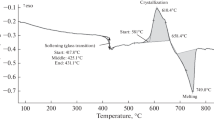Abstract
The objective of this study was to characterize the moisture sorption of magnesium stearate and the morphological changes, if any, resulting from moisture sorption. Six samples of commercial magnesium stearate USP were examined. Moisture sorption isotherms were obtained at 25°C and 5% to 98% relative humidity (RH) using a moisture balance. Changes in crystal form resulting from moisture sorption were determined by x-ray diffraction. There were differences in the shape of the isotherm, reversibility of moisture uptake, and shape of the hysteresis loop in the isotherms of crystalline and amorphous magnesium stearates. The isotherm of crystalline magnesium stearate was almost parallel to the pressure axis until and RH of ∼80%. The isotherm of the amorphous sample was characterized by continuous uptake of water over the entire range of RH. Exposure of amorphous magnesium stearate to RH greater than 70% resulted in the formation of the trihydrate. The trihydrate was converted into the anhydrous form when heated to a temperature of 100°C to 105°C. The trihydrate could be generated by exposing the anhydrate to RH higher than 70%.
Similar content being viewed by others
References
Carstensen JT. In: Pharmaceutics of Solids and Solid Dosage Forms. New York: Wiley-Interscience; 1977.
Conners KA, Amidon GL, Stella VJ. In: Chemical Stability of Pharmaceuticals. New York: Wiley-Interscience; 1986.
Ertel KD, Carstensen JT. Chemical, physical, and lubricant properties of magnesium stearate. J Pharm Sci. 1988;77(7):625–629.
Muller BW. Advances in tablet technology, part 3. Pharm Ind. 1972;39:161.
Muller BW. Advances in tablet technology, part 2: the structure of magnesium stearate films. Pharm Ind. 1976;38:394.
Muller BW. Polymorphism of magnesium stearate and the influence of the crystal structure on the lubricating behavior of excipients. Paper presented at: First International Conference on Pharmaceutical Technology; June 1977; Paris, France.
Wada Y, Matsuhara T. Pseudopolymorphism and lubricating properties of magnesium stearate. Powder Technol. 1994;78:109–114.
Nyqvist H. Saturated salt solutions for maintaining specified relative humidities. Int J Pharm Tech Prod Mfr. 1983;4(2):47–48.
Klug HP, Alexander LE. X-ray Diffraction Procedures for Polycrystalline and Amorphous Materials. New York: John Wiley & Sons; 1974.
Zettlemoyer AC. Hydrophobic surfaces. Coll Interface Sci. 1968;28:343–368.
Levine H, Slade L. In: Franks F, ed. Water Science Reviews, Vol. 3. Cambridge, UK: Cambridge University Press; 1987.
Byrn SR. Solid State Chemistry of Drugs. New York: Academic Press; 1982:149.
Author information
Authors and Affiliations
Additional information
Published: December 3, 2001
Rights and permissions
About this article
Cite this article
Swaminathan, V., Kildsig, D.O. An examination of the moisture sorption characteristics of commercial magnesium stearate. AAPS PharmSciTech 2, 28 (2001). https://doi.org/10.1208/pt020428
Received:
Accepted:
Published:
DOI: https://doi.org/10.1208/pt020428




